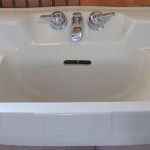Essential Considerations for a Successful Bathroom Sink Replacement
Whether you're renovating your bathroom or simply replacing an outdated sink, understanding the key aspects of the process will ensure a seamless and satisfactory outcome. Here are some essential considerations to guide you through a successful bathroom sink replacement.
1. Sink Material and Style
The sink material and style play a significant role in aesthetics and functionality. Consider the following options and their pros and cons:
- Ceramics: Durable, easy-to-clean, and available in various colors and designs.
- Natural Stone: Luxurious, unique, and requires sealing for durability.
- Glass: Modern, stylish, and comes in transparent or opaque finishes.
- Stainless Steel: Durable, hygienic, and resistant to rust and stains.
2. Sink Shape and Size
Choose a sink shape and size that complements the bathroom layout and your needs. Consider the following options:
- Rectangular: Simple, versatile, and available in various sizes.
- Oval: Softer lines, ideal for smaller bathrooms or as centerpieces.
- Round: Compact and versatile, suitable for corners or limited spaces.
- Vessel: Sits on the countertop, creating a contemporary or traditional aesthetic.
3. Faucet Hole Configuration
Determine the number and placement of faucet holes in the sink. The most common configurations are:
- Single-hole: Requires a faucet with a built-in handle.
- Two-hole: Separate holes for the handle and spout.
- Three-hole: Two holes for the handles and one for the spout.
4. Sink Undermount or Drop-in
Undermount sinks are installed below the countertop, creating a seamless and modern look. Drop-in sinks sit on top of the countertop, providing a more traditional and easy-to-install option.
5. Vanity and Countertop
If you're replacing the sink as part of a larger vanity or countertop renovation, consider the compatibility of materials and finishes. Ensure the sink size and style match the vanity and countertop design.
6. Plumbing Access and Shut-off Valves
Plan for adequate plumbing access beneath the sink for maintenance and repairs. Ensure there are shut-off valves installed for both hot and cold water supply lines.
7. Professional Installation
While some homeowners may feel confident replacing a sink, it's advisable to consider professional installation for technical precision and safety. A qualified plumber can ensure proper sealing, prevent leaks, and connect the plumbing correctly.
Conclusion
Replacing a bathroom sink can transform the aesthetics and functionality of your space. By carefully considering the material, style, size, and other essential factors, you can achieve a successful outcome. Remember, thorough planning and, if necessary, professional installation will ensure a lasting and satisfactory result for years to come.

4 Ways To Replace A Bathroom Sink Wikihow

Diy Guide Find Out How To Replace A Bathroom Sink Ron Hazelton
:max_bytes(150000):strip_icc()/7_remove-vanity-top-56a4a26d3df78cf772835b2d.jpg?strip=all)
How To Remove A Bathroom Vanity Cabinet

How To Replace A Bathroom Faucet Tinged Blue

Bathroom Faucet Replacement For Beginners Making Maanita

How To Remove And Replace A Bathroom Sink Diy

How To Replace A Bathroom Faucet Removal And Installation

How To Remove An Old Bathroom Sink

Bathroom Sink Repair What You Need To Know In 2024

Bathroom Sink Repair A Complete Guide Homeadvisor
Related Posts







